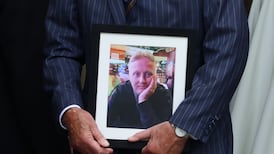For the first time in a 40-year search for answers about his brother’s murder, Seamus Kearney feels closure.
Days before the publication of an inquiry into the activities of the British Army’s top IRA spy during the Troubles, the Belfast man sat across a table from its investigators and learned about the final moments of his younger brother, Michael, who asked to say a prayer before he was “executed” by the IRA for “being an informer” in 1979.
Crucially, Seamus Kearney was told by the Operation Kenova team this week what he’d always suspected – Michael’s death could have been prevented.
“My solicitor was with me along with Michael’s twin, Sean, and formally them if Michael’s life could have been saved by the intervention of the security forces. An investigator told us categorically that his life could have been saved and that the security forces failed.
READ MORE
“Michael was only a kid, he was only 20. He didn’t deserve that.”
It is believed the trainee electrician’s abduction and death is the first case linked to the double agent, Stakeknife, widely identified as Freddie Scappaticci, who oversaw the IRA’s notorious Internal Security Unit or “nutting squad”.
For the past six years, Seamus Kearney has been co-operating with Operation Kenova to find the “missing pieces of the jigsaw” after spending decades pursuing justice.
“A Kenova investigator said they’d hoped they gone the extra mile for me. They did,” he told The Irish Times.
Michael Kearney grew up in Belfast at the height of the Troubles and joined the IRA in 1978 at a time when Seamus Kearney, also a former IRA member, was in prison.
Following his release in 1986, Seamus was asked by his mother to find out if her son “really was an informer”.
In an unprecedented move, Michael Kearney’s name was “cleared” in 2003 following an internal IRA investigation which confirmed he was not an informer.
“I will never give up for our Mick and had already found out a lot. But the Kenova team gave me information that I had never heard before. I now know he died instantly and that he wasn’t crying before he was shot. It’s strange but that was important for me, he held on to his dignity.
“He was innocent but there was no way he was getting out of that after Scappaticci interrogated him.
“I know Michael’s life could have been saved, he could have had a life. He could have had a family, he had potential. He joined the IRA to help me.”
The Kenova team also disclosed what Seamus Kearney described as “damning” findings about the British army’s handling of intelligence in relation to his brother; he continues to pursue a civil case he lodged last year.
He insists however he doesn’t feel anger towards the security services.
“I got closure, there is such a thing as closure, and I got it this week. My brother Sean felt the same. I went home and phoned my daughter in Australia and told her it was good news, that we’d finally got closure.”
Following the publication of the 206-page report on Friday, the two brothers met before Seamus caught a train for an evening away.
“Sean’s wife said to us, ‘that’s one hell of a result you got’. I smiled and told her she was right.”
- Listen to our Inside Politics Podcast for the latest analysis and chat
- Sign up for push alerts and have the best news, analysis and comment delivered directly to your phone
- Find The Irish Times on WhatsApp and stay up to date










